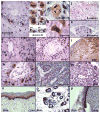Oral epithelial stem cells - implications in normal development and cancer metastasis
- PMID: 24803391
- PMCID: PMC4157336
- DOI: 10.1016/j.yexcr.2014.04.021
Oral epithelial stem cells - implications in normal development and cancer metastasis
Abstract
Oral mucosa is continuously exposed to environmental forces and has to be constantly renewed. Accordingly, the oral mucosa epithelium contains a large reservoir of epithelial stem cells necessary for tissue homeostasis. Despite considerable scientific advances in stem cell behavior in a number of tissues, fewer studies have been devoted to the stem cells in the oral epithelium. Most of oral mucosa stem cells studies are focused on identifying cancer stem cells (CSC) in oral squamous cell carcinomas (OSCCs) among other head and neck cancers. OSCCs are the most prevalent epithelial tumors of the head and neck region, marked by their aggressiveness and invasiveness. Due to their highly tumorigenic properties, it has been suggested that CSC may be the critical population of cancer cells in the development of OSCC metastasis. This review presents a brief overview of epithelium stem cells with implications in oral health, and the clinical implications of the CSC concept in OSCC metastatic dissemination.
Keywords: Cancer stem cells; Epithelial stem cells; Invasion; Metastasis; Oral mucosa; Oral squamous cell carcinoma.
Copyright © 2014. Published by Elsevier Inc.
Figures


References
-
- Iglesias-Bartolome R, Callejas-Valera JL, Gutkind JS. Control of the epithelial stem cell epigenome: the shaping of epithelial stem cell identity. Current opinion in cell biology. 2013;25:162–169. - PubMed
-
- Sinha N, Mukhopadhyay S, Das DN, Panda PK, Bhutia SK. Relevance of cancer initiating/stem cells in carcinogenesis and therapy resistance in oral cancer. Oral oncology. 2013;49:854–862. - PubMed
-
- Winning TA, Townsend GC. Oral mucosal embryology and histology. Clin Dermatol. 2000;18:499–511. - PubMed
-
- Rothova M, Thompson H, Lickert H, Tucker AS. Lineage tracing of the endoderm during oral development. Dev Dyn. 2012;241:1183–1191. - PubMed
Publication types
MeSH terms
Grants and funding
LinkOut - more resources
Full Text Sources
Other Literature Sources
Medical

